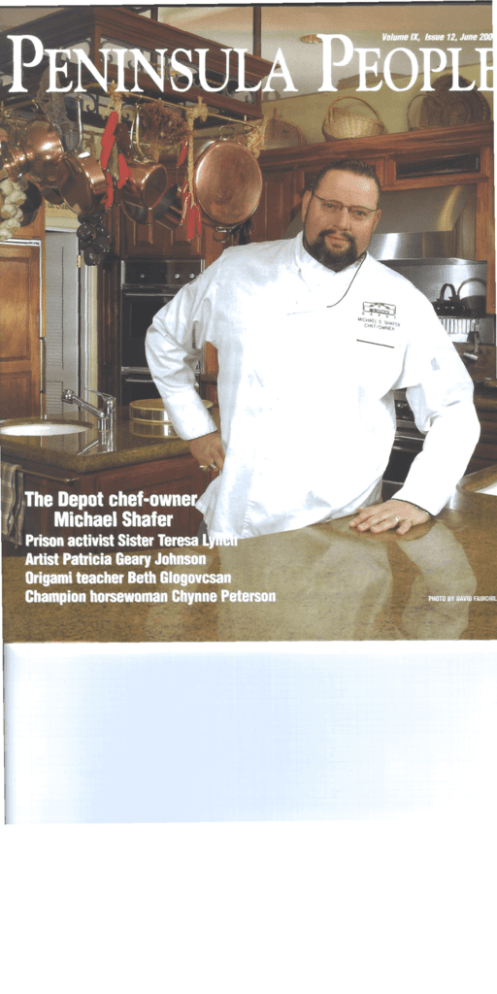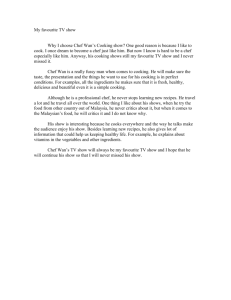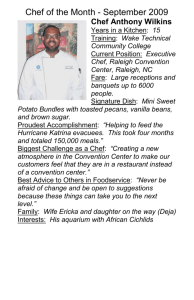to read about Chef Shafer in the June '05 issue of Peninsula People!
advertisement

The Depot Chef Michael Shafer with Marie-Joelle Unatin in the backyard of her Peninsula home, one of the venues for Celebrate Chefs benefit, June 9 presented by the Associates of the Palos Verdes Art Center. Photo by David Fairchild Settling down to a good meal by Richard Foss Many people drift through life, only gradually realizing that their job has become a A Caribbean restaurant in career. Chef Michael Shafer of The Depot knows exactly when he decided that he Vienna, where the would spend his life in the restaurant business. partners drank the profits, "It was May 1977," he remembered. "I had worked at the Century Plaza and other adventures of a Hotel for three weeks, and it was their busiest week of the year. It was called Affiliate globe trotting chef Week - back in the days of only three networks. ABC, NBC, and CBS brought in local station executives from across the nation for a week to wine and dine them and show them all the new shows for the fall. Every network would try to outdo the other networks, and what normally would be a $10 million month for our catering department would be a $30 million month. At that point, I knew that this was the level of excitement and intensity that I was looking for. After that, I went back to school and enrolled in a three year apprenticeship program." Shafer hadn't originally planned to be a chef. As he puts it, “At first cooking was purely a job, a capitalistic endeavor to support my extracurricular activities. I was going to college because I thought I was going to be an art teacher. I moved to LA in '77 to become a world-famous photographer - I was going to be a photojournalistic guru for the stars and rock stars. I found that nobody really cared that I had photographed rock concerts in Buffalo for the local newspaper. They weren't going to open the door for me, so I went back to cooking. That was where I met my mentor, Walter Roth, the corporate executive chef for Westin Hotels. He showed me that this was not a job, but a profession." Shafer never turned back, though he is still an amateur photographer whose office is festooned with pictures of his children. These images fight for space with cookbooks, golf trophies, and awards for international cooking competitions. Shafer still has a lively appreciation for other people's art, but cooking is his art now. He uses the full arsenal of techniques that he developed from his early days in New York, his years at the Century Plaza, and his extensive career in Europe. While Chef Shafer is noted for adding subtle Asian influences to his cooking, he ha never worked in the Orient; rather, the style was a result of his schooling in Los Angeles. "Once a week while I was an apprentice, had to go downtown to LA Trade Tech for three-hour theoretical lecture. Afterwards, I'd hang out in Chinatown with some of the other apprentices, and we'd all go back to my place in the Marina and cook. That was where developed my style. And it's not just Asia because there's an influence of when I worked in Scandinavia, and my German and Austria experience, and my respect for Escoffier an classic cuisine. There's that blend there - I have my Asian cured salmon on my menu, and it's Scandinavian gravlax, but cured with Asia ingredients rather than dill and aquavit. It' that crossover cooking, which was really novel when I started doing it." Some of Shafer's European experience was a the famed Bristol Hotel in Paris and the Palais Schwartzenberg in Vienna, places where young American chef could practice the classic dishes. From there, his experiences turned in quirky and eclectic direction. "I opened up a Caribbean restaurant and bar in Vienna, the first place where I designed the menus myself," he reminisced. "It did great until the partners drank more than they watched the business. After that, I moved to Norway, where I was the executive souschef for a 600 room hotel in Oslo. My main job there was to internationalize the menus. The hotel had a little street corner cafe, and I was doing stuff like tacos and burritos and tostadas, and it was flipping people out. I was doing nouvelle cuisine in the fine dining room, because that was what was happening in the culinary world at that time. Everyone there was used to traditional Norwegian stuff, which was pretty bland and boring. When we served traditional banquets there, we would serve the main course, but have waiters strolling with extra boiled potatoes, because that's what people wanted. Plain boiled potatoes, that's all. In order to please people I learned Norwegian cuisine. I still use the gravlax and some of the sauce techniques in my cooking, but that's about it." When the novelty of making the only burritos in Oslo palled, Chef Shafer returned to Los Angeles where the Century Plaza was opening a new tower. At the age of 27 he had five sous-chefs working under him, with 60 cooks following their directions. What was most important was the creative freedom, since the revenue from the rooms subsidized his restaurants. "The hotel was such a great way to learn," he recalled happily. "The money was secondary - if you have a very successful hotel, you get to play. You get to go to all these culinary competitions, which are purely art and a total waste of money. I won the gold medal in the culinary Olympics in Frankfurt, Germany. I had to make 20 different dishes. One of the ones I came up with for that event was the rock shrimp sausages, which are still on my menu." Though he was happy at the remodeled Century Plaza for a while, greener pastures beckoned - at least, they seemed greener when he first looked at them. Chef Shafer's first job with his next employer, Stouffer Hotels, had a wonderful side effect, but the second posting was disastrous. "I opened up Stouffer LAX, where I met my wife. She was installing the computer system there. We met and have been together since. Shortly afterward, the company took over a number of other properties, and we went to Texas and I was the Executive Chef of the Stouffer Austin hotel. I call that my dark year. Texas back then was a culinary hell, not even a wasteland, hell. They wanted chicken fried steak with gravy, that was it, and the gravy could not be seasoned. It was a tough year. Two months after I got there, I had two headhunters looking for a job for me back in California. The bad part is that by the time I left, I had turned the hotel around. The food and beverage got critical acclaim, the place was financially sound, and everybody totally freaked out when they heard I was leaving. Especially when they heard where I was going. I went with Doubletree hotels, which at the time was in its infancy, and nobody realized it was going to grow. I just wanted to get out of Texas, so I took it over. I was very happy with them for three years, and I opened or took over the metamorphosis of about 10 hotels. I was their Western regional corporate chef, and I traveled a lot and had a great time. Then I sat next to my expartner at a dinner, and 12 years ago we opened this place." Robert Bell of the Chez Melange Group shared two passions with Michael Shafer: cooking and golf. The two started out talking about golf at a meeting of Le Toque Blanche, a chef's organization. Before long they were talking about restaurants, and Michael mentioned his plan to eventually open his own place. Bell was then consulting for several other chefs with the same ambition, and he made Schafer an offer: take him out for a round of golf, and afterward Bell would review his plans for free. Shafer obliged, and Bell loved the concept. At the end of the game, Bell said, "Wouldn't that be funny if we did something together." A few weeks later the two men played golf again, and Bell said "I've got a restaurant opening up - how'd you like to be my chef?" Shafer said, "I'd like to be your partner." Bell said, "OK, fine" and a partnership was born. For seven years Shafer, Bell, and Michael Franks were partners in the Melange Group, and The Depot became famous as the engine for the revitalization of downtown Torrance. The restaurant received favorable press coverage in national magazines and earned a devoted following in the area. Shafer left the partnership amicably in 2000, and the three men are still friends and actively support each other's charity events. The Depot continues to reflect Shafer's idiosyncratic global vision, and continues to sponsor events for the Project New Hope AIDS hospice and the Pediatric Therapy Network. Shafer became aware of the latter group simply because their headquarters was adjacent to the Depot. As a neighborly gesture, Shafer ran a charity event that brought in over 60 people and raised almost $30,000. After five years of running the annual event, over 600 people had attended, raising over $130,000. Shafer had no idea that his benevolent actions were benefiting a group that would eventually help his own family. "After four or five years of my doing an event for them, my youngest son Noah didn't develop speech. He understood everything, and he got whatever he wanted without oral communication, but he just wouldn't talk. I finally asked the people at the PTN to help me, and they were thrilled that I finally wanted for something in return for the events I had been running. In two months, he was yapping like you wouldn't believe, and now we wish he would shut up. They're miracle workers there, and I would do anything for them." While Shafer still loves cooking and managing a restaurant, he doesn't necessarily want his children to follow in his footsteps. "They should only consider working in restaurants if they truly have the passion for the business. I would not want them to take over the restaurant just because it's a family business - I'd rather sell it than do that to them. I almost discourage them, in a way. I tell them that if they can go to Mc Donald's, Denny's, anywhere, and if they still love cooking after a 40 hour week, go for it. If my kids develop a passion for this, love food, wine, entertaining, the sadistic drive that it takes to run a restaurant, then I'll say fine, come on in." Meanwhile, Shafer enjoys the freedom to spend time with his children that comes from owning his own business. "I have breakfast with my kids each morning - that's our big meal. When we are together, I make it count. One of the good things about running my own business is that I make it to every school play, every school event. Yesterday they got out of school early - they go to Dapplegray. I picked them up and we went golfing. I have that luxury because I work for myself, and I can leave the restaurant to take time with them." Shafer says he isn't tempted by the occasional offers to franchise or expand his enterprise. "I tell them this: I have zero partners, zero debt, I play golf four or five times a week, I have the house I always dreamed of, my wife is happy - why would I screw it up?" Michael Shafer will be participating in Celebrate Chefs a series of five gourmet events by renowned South Bay chefs, that will take diners on an epicurean journey to five fabulous Peninsula homes June 9 -12, presented by the Associates of the Palos Verdes Art Center benefiting their visual arts education, exhibition and community programs. Tickets are $125 per participant per meal, and only 100 seats are available for each meal. See Community Calendar for further details, or contact the Palos Verdes Art Center at 310-541-2479. PEN Peninsula People • June 2005






